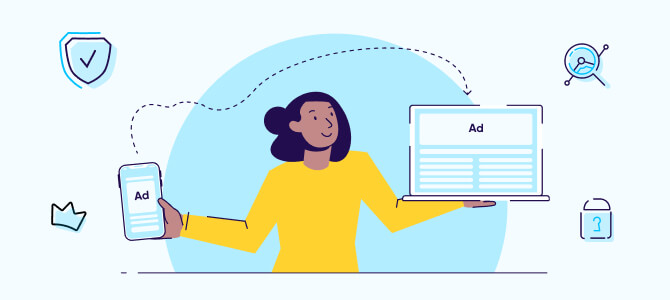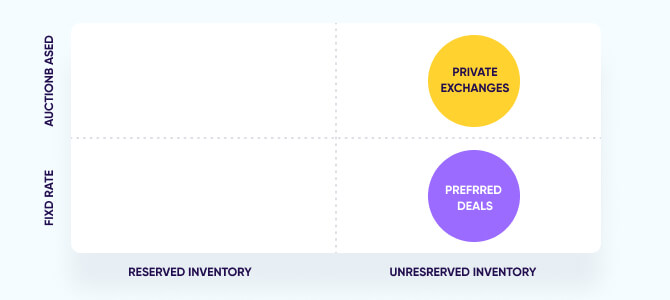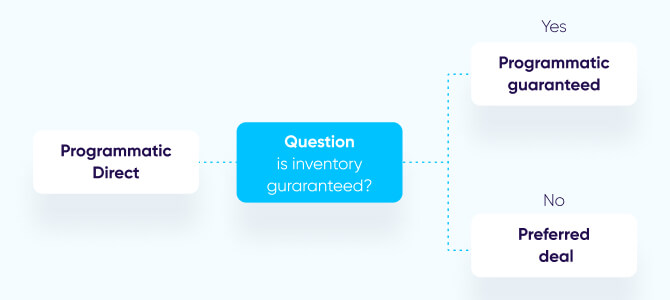
Preferred Deals

Also known as programmatic non-guaranteed, a preferred deal is an arrangement where a publisher (seller) agrees to provide an advertiser (buyer) with preferential access to inventory. The advertiser, in turn, gets early-bird inventory access in exchange for a fixed, pre-negotiated CPM.
What are preferred deals?
A type of programmatic direct advertising, preferred deals directly connect publishers and advertisers. An agreement is set up between both parties where the publisher consents to offer advertisers preferential access to inventory at a pre-negotiated CPM.
However, the inventory isn’t reserved for a specific advertiser. Instead, buyers get the first opportunity to check the inventory and decide whether they want to buy it.
If a buyer doesn’t accept the deal, the ad publisher can sell their inventory in a private marketplace or open auction. Also, the publisher can choose to negotiate preferred deals with various advertisers.
Additionally, granular campaign details, such as impressions and dates, aren’t set in stone. That’s why preferred deals are also known as programmatic non-guaranteed.
How do preferred deals work?
Both publishers and advertisers can initiate a preferred deal.
If a publisher initiates it:
- They invite advertisers to participate in a preferred deal (sometimes using platforms like Google Ad Manager)
- Interested advertisers accept the invitation and get in touch with the publisher
- Both parties negotiate terms, including impressions and CPM
- The publisher outlines a proposal and shares it
- Both parties finalize the deal and begin the campaign
If an advertiser initiates it:
- They find a website or app that fits their requirements and reach out to the publisher
- The publisher reverts with more details and negotiates the CPM
- The advertiser places an order for the inventory
- The publisher reviews the order and begins the campaign
Top 4 benefits of preferred deals for publishers

Preferred deals offer several advantages to both publishers and advertisers. Among which are:
1 – Predictable revenue
Preferred deals eliminate the need for auctioning inventory. Also, unlike an open auction, inventory prices aren’t driven by bidding. Instead, publishers get the advantage of a fixed CPM, providing them with a more predictable revenue stream. That, in turn, gives publishers more control over their revenue.
2 – Premium price
Instead of waiting for advertisers to bid for inventory, preferred deals let publishers set a fixed CPM. Considering that advertisers get the first-look advantage, they’re willing to pay a higher price. This helps publishers maximize their revenue.
3 – More flexibility
With preferred deals, publishers aren’t dependent on a limited set of advertisers. Instead, they always have the option to sell their inventory in an open market if an advertiser doesn’t accept their deal. This helps them maximize their revenues and ad quality without having to depend on the advertisers.
4 – Quality control
Preferred deals provide advertisers with the assurance of delivering their campaigns in a brand-safe environment. Besides improving ad performance, it also ensures better quality traffic — because the buyer and seller agree to specific ad placements before finalizing a deal.
The best part is that advertisers always have the option to pass off an inventory if it doesn’t suit their needs.
Disadvantages of preferred deals
Despite the lucrative benefits of preferred deals, they might come with a few drawbacks:
For publishers
- The most significant downside of preferred deals is that publishers are still at risk of unfulfilled inventory because an advertiser isn’t obligated to buy it. If they decide to pass on the opportunity, the inventory will move to a private auction and, subsequently, to the open market.
- There’s also a chance that the inventory will remain unfulfilled throughout these transfers, which could take a toll on the publisher’s revenue.
- Lastly, preferred deals may not be the best for newer or smaller publishers. Unless a publisher is well-known, it’s likely that they’ll struggle to grab the attention of advertisers with preferred deals.
For advertisers
- Preferred deals aren’t set in stone. That means an advertiser might have to compete with other buyers for a particular inventory.
- Early access to premium inventory means a higher CPM than they’d get in an open market.
- Unlike an open auction, preferred deals don’t give advertisers a benchmark for the price of an inventory. That makes it crucial to assess the publisher’s credibility and trustworthiness before negotiating the price.
- Lastly, it’s up to advertisers to find the right publisher whose audience aligns with their target demographic. That makes the process more complex and time-consuming.
Preferred deals vs. private auctions

Both preferred deals and private auctions let publishers invite advertisers to buy their inventory, often leading advertisers to believe that they’re the same model.
However, there’s a crucial underlying difference between the two methods:
In a private auction, a publisher gets to invite a handful of advertisers to bid for their inventory. The publisher sets a floor price and has complete control over who participates in the auction.
Each advertiser can then place their bid in real-time, and the highest bid wins the auction. A private auction is also known as a private marketplace or an invitation-only auction.
Unlike private auctions, a preferred deal doesn’t involve real-time bidding. Instead, each advertiser must pay a fixed, pre-negotiated CPM to buy inventory. Additionally, a private auction doesn’t give buyers early-bird access and gets lower priority in ad servers.
Preferred deals vs. programmatic guaranteed

Advertisers often think that preferred deals and programmatic guaranteed are the same thing because both models offer exclusive inventory access. However, with programmatic guaranteed, a publisher reserves ad inventory for a particular buyer.
The publisher also guarantees a certain number of impressions in exchange for a fixed price. Other details, such as price, date range, and ad placement, are also negotiated beforehand.
On the other hand, preferred deals don’t require publishers to reserve inventory for specific buyers, don’t guarantee a fixed volume of impressions, and also get lower priority in ad servers than programmatic guaranteed.
Unlike programmatic guaranteed, preferred deals allow publishers to approach more than one advertiser and can even finalize deals with multiple ones. That means more competition for interested advertisers.
Should you go with preferred deals?
As an advertiser, it’s a good idea to weigh preferred deals’ pros and cons before buying ad inventory.
They’re ideal when you want to reach a specific audience segment without being obligated to an agreement, and are particularly useful when you already have a clear idea of your target demographic and have identified suitable publishers.
However, it’s essential to vet the publisher and analyze their current traffic patterns before negotiating a deal.
Key takeaways
- A preferred deal is a one-on-one agreement between a publisher and an advertiser that promises preferential inventory access for a pre-negotiated CPM.
- The inventory isn’t reserved for a specific advertiser, and if one doesn’t buy the available inventory, the publisher can sell it in private or open auctions.
- Benefits of preferred deals for publishers include:
- Revenue predictability
- Quality control
- Higher earning potential
- Benefits of preferred deals for advertisers include:
- Better brand safety and high-quality traffic
- Minimal chances of ad fraud
- Improved transparency
- On the drawbacks side, advertisers have to go through the trouble of finding suitable publishers who are worth the higher price tag of a preferred deal, and might have to compete with other buyers for ad inventory.
- Preferred deals are ideal when you want to reach a specific audience segment without being obligated to an agreement, and are particularly useful when you already have a clear idea of your target demographic and suitable publishers.
Either way, be sure to weigh the pros and cons before going ahead with preferred deals.



